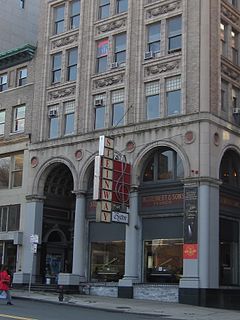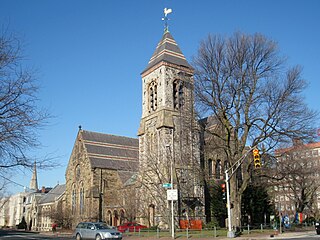
Beacon Hill is a historic neighborhood in Boston, Massachusetts, and the hill upon which the Massachusetts State House resides. The term "Beacon Hill" is used locally as a metonym to refer to the state government or the legislature itself, much like Washington, D.C.'s "Capitol Hill" does at the federal level.

The Back Bay Fens, often called The Fens, is a parkland and urban wild in Boston, Massachusetts, in the United States. It was established in 1879. Designed by Frederick Law Olmsted to serve as a link in the Emerald Necklace park system, the Fens gives its name to the Fenway-Kenmore neighborhood.

The Pilgrim Monument in Provincetown, Massachusetts, was built between 1907 and 1910 to commemorate the first landfall of the Pilgrims in 1620 and the signing of the Mayflower Compact in Provincetown Harbor. This 252-foot-7+1⁄2-inch-tall (77.0 m) campanile is the tallest all-granite structure in the United States and is part of the Provincetown Historic District.

The Crowninshield House is a historic house at 164 Marlborough Street in the Back Bay neighborhood of Boston, Massachusetts. Built in 1870, it is the first residential design of the renowned architect Henry Hobson Richardson. It was added to the National Register of Historic Places in 1972.

The Tavern Club, 4 Boylston Place in downtown Boston, Massachusetts, is a private social club established in 1884.
Pauline Revere Thayer (1862–1934) worked to improve immigrant conditions in Massachusetts and the US; represented Massachusetts in Republican party activities; and founded the Chilton Club in Boston in 1910. Born in Quincy, Massachusetts, in 1860 to Paul Revere III, she was a direct descendant of Paul Revere, and in that capacity performed civic and honorary duties in his memory. She married businessman Nathaniel Thayer III in 1887. Throughout her life, she pursued charitable endeavors. In 1896 she was treasurer of the Committee of Women of the Massachusetts Volunteer Aid Association, contributing to efforts benefitting American soldiers in the Spanish–American War. She also donated funds to the Massachusetts General Hospital. In 1910 she founded the private women's Chilton Club in Boston.
J. Pickering Putnam also known as J.P. Putnam or John Pickering Putnam, was an American architect and designer who "pioneered the concept of the modern apartment building." He designed several buildings in the Back Bay area of Boston, Massachusetts. He earned a number of design patents related to plumbing, ventilation, and the like, such as US Patent No.563,064 (1896), a design for a washbasin.
The Hollis Street Theatre (1885–1935) was a theatre in Boston, Massachusetts, that presented dramatic plays, opera, musical concerts, and other entertainments.

North Square in the North End of Boston, Massachusetts, USA, sits at the intersection of Moon, Prince, North, Garden Court and Sun Court Streets. Paul Revere lived here, as did other notables in the 17th and 18th centuries. Prior to July 4, 1788, the area was known as Clark's Square.

The Custom House Block, built in 1845-87 in Boston, Massachusetts, is a former warehouse located on Long Wharf, at the end of State Street. Architect Isaiah Rogers designed the four-storey building, constructed of granite and brick. In its 19th-century heyday, it contributed to the life of "Boston's busiest pier, commercial port, and embarkation point for travelers." Today private owners maintain the site.
Andrews, Jaques and Rantoul was an American architectural firm founded in Boston, Massachusetts in 1885 by Robert Day Andrews, Herbert Jaques and Augustus Neal Rantoul. The firm designed numerous buildings that are listed on the U.S. National Register of Historic Places. Their works include:
Beethoven Hall (1874-1878) was an auditorium in Boston, Massachusetts, that hosted musical performances and other entertainments in the 1870s. It sat on Washington Street, near Boylston Street, in today's Boston Theater District/Chinatown neighborhood. The architect was William Washburn, who had also designed the first National Theatre and the second Tremont Temple.
Grundmann Studios (1893–1917) in Boston, Massachusetts, was a building on Clarendon Street in the Back Bay. It contained artist's workspaces and multipurpose function rooms Copley Hall and Allston Hall. Prior to 1893, it functioned as a skating rink; after the Boston Art Students' Association leased the building it was renamed in honor of local art educator Emil Otto Grundmann. The Massachusetts Institute of Technology owned the property. Tenants included the Copley Society ; artists Henry R. Blaney, Herman Dudley Murphy, Frank Richmond, Mary Bradish Titcomb; sculptor John A. Wilson, architect Josephine Wright Chapman; and the College Club. The structure existed until 1917, when it was demolished.
The Plymouth Theatre (1911–1957) of Boston, Massachusetts, was located on Stuart Street in today's Boston Theater District. Architect Clarence Blackall designed the building for Liebler & Co. Performers included Henry Jewett, Bill "Bojangles" Robinson, 8-year-old Sammy Davis, Jr., and Bette Davis. In October 1911, the touring Abbey Theatre presented Synge's Playboy of the Western World at the Plymouth; in the audience were W. B. Yeats, Isabella Stewart Gardner and Rose Fitzgerald Kennedy.

Steinert Hall of Boston, Massachusetts, stands at 162 Boylston Street on what was called Boston's "piano row", opposite the Common in the Boston Theater District.

The Flour and Grain Exchange Building is a 19th-century office building in Boston. Located at 177 Milk Street in the Custom House District, at the edge of the Financial District near the waterfront, it is distinguished by the large black slate conical roof at its western end. It is referred to as the Grain Exchange Building and sometimes as the Boston Chamber of Commerce Building.

Pauline Lennards Palmer was an American artist based in Chicago.

Nathaniel Thayer was an American banker and railroad executive.
Walter Atherton (1863–1945) was an architect and draftsman born in Stoughton, Massachusetts, United States. A Harvard alumni, he also studied at the Massachusetts Institute of Technology in Cambridge and at the École nationale supérieure des Beaux-Arts in Paris for two years. He designed many schools, other public buildings and homes in New England, New York and New Jersey.

Abel C. Martin (1831-1879), often referred to as A. C. Martin, was an American architect who worked in Boston, Massachusetts during the nineteenth century.













